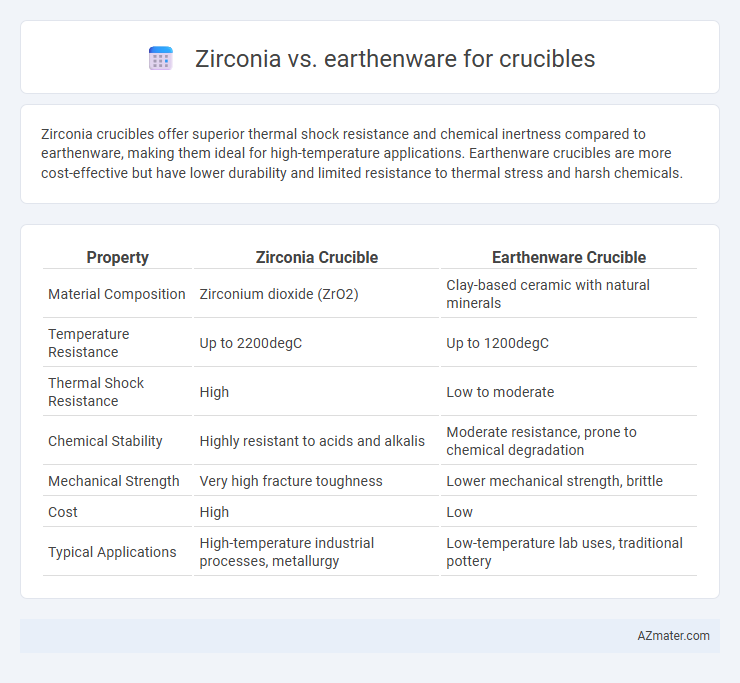Zirconia crucibles offer superior thermal shock resistance and chemical inertness compared to earthenware, making them ideal for high-temperature applications. Earthenware crucibles are more cost-effective but have lower durability and limited resistance to thermal stress and harsh chemicals.
Table of Comparison
| Property | Zirconia Crucible | Earthenware Crucible |
|---|---|---|
| Material Composition | Zirconium dioxide (ZrO2) | Clay-based ceramic with natural minerals |
| Temperature Resistance | Up to 2200degC | Up to 1200degC |
| Thermal Shock Resistance | High | Low to moderate |
| Chemical Stability | Highly resistant to acids and alkalis | Moderate resistance, prone to chemical degradation |
| Mechanical Strength | Very high fracture toughness | Lower mechanical strength, brittle |
| Cost | High | Low |
| Typical Applications | High-temperature industrial processes, metallurgy | Low-temperature lab uses, traditional pottery |
Introduction to Crucible Materials
Crucibles made from zirconia exhibit superior thermal stability and high resistance to thermal shock, making them ideal for high-temperature applications beyond 2000degC. Earthenware crucibles, composed primarily of natural clay and silica, offer cost-effective solutions suitable for lower-temperature processes below 1200degC but lack the durability and chemical resistance of zirconia. Choosing between zirconia and earthenware depends on the specific temperature requirements and chemical environment of the metallurgical or laboratory operation.
What is Zirconia?
Zirconia, or zirconium dioxide, is a highly durable ceramic material known for its exceptional thermal stability and resistance to chemical corrosion, making it ideal for crucibles used in high-temperature applications. Unlike earthenware, which is made from porous clay and has lower thermal shock resistance, zirconia crucibles offer superior strength and longevity in extreme heat environments. Their dense, non-porous structure ensures minimal contamination and high purity during melting or laboratory processes.
What is Earthenware?
Earthenware is a porous ceramic material made from natural clay fired at relatively low temperatures between 1,000degC and 1,150degC, resulting in a more porous and less durable crucible compared to zirconia. It is commonly used for crucibles in low to medium temperature applications due to its affordability and ease of shaping but lacks the high thermal shock resistance and chemical inertness of zirconia crucibles. Zirconia crucibles, crafted from zirconium dioxide, offer superior strength, durability, and resistance to extreme temperatures above 2,000degC, making them ideal for demanding metallurgical and chemical processes.
Thermal Resistance: Zirconia vs Earthenware
Zirconia crucibles exhibit superior thermal resistance compared to earthenware, withstanding temperatures up to 2200degC without deformation or cracking. Earthenware crucibles typically endure maximum temperatures around 1100degC to 1200degC, making them less suitable for high-temperature applications. The high thermal shock resistance of zirconia enhances its durability and longevity in repeated heating cycles, unlike earthenware which is more prone to thermal stress damage.
Chemical Stability Comparison
Zirconia crucibles exhibit superior chemical stability compared to earthenware, resisting corrosion from acids, alkalis, and molten metals at high temperatures. Earthenware, primarily composed of porous clay, is more reactive and susceptible to degradation during prolonged exposure to aggressive chemical environments. This makes zirconia the preferred choice for applications requiring exceptional durability and minimal contamination in chemical processes.
Mechanical Strength and Durability
Zirconia crucibles exhibit superior mechanical strength and durability compared to earthenware, with a high fracture toughness that resists cracking under thermal and mechanical stress. Earthenware crucibles, while cost-effective, possess lower tensile strength and are more prone to chipping, making them less suitable for high-temperature or heavy-duty applications. The advanced ceramic structure of zirconia enables prolonged lifespan and consistent performance in demanding laboratory and industrial processes.
Cost and Availability
Zirconia crucibles are significantly more expensive than earthenware due to their superior thermal stability and resistance to chemical corrosion, making them ideal for high-temperature applications. Earthenware crucibles offer greater affordability and are widely available, commonly used in general laboratory tasks and lower-temperature processes. The choice between the two depends on budget constraints and specific temperature requirements, with earthenware being preferred for cost efficiency and zirconia for durability in extreme conditions.
Common Applications in Laboratories
Zirconia crucibles are widely used in laboratories for high-temperature applications such as melting metals and conducting chemical reactions due to their superior thermal stability and resistance to corrosion. Earthenware crucibles, commonly utilized for low-temperature heating and ash content determination, offer affordability but limited durability under extreme conditions. Laboratory processes involving high thermal shock or corrosive environments preferentially use zirconia to ensure accuracy and longevity.
Pros and Cons of Zirconia Crucibles
Zirconia crucibles offer exceptional thermal shock resistance and chemical inertness, making them ideal for high-temperature applications involving aggressive materials. They provide superior mechanical strength and longer lifespan compared to earthenware crucibles, which are more prone to cracking and contamination at elevated temperatures. However, zirconia crucibles are significantly more expensive and heavier, limiting their use in cost-sensitive or portable scenarios.
Pros and Cons of Earthenware Crucibles
Earthenware crucibles are inexpensive and widely available, making them suitable for low-temperature applications and educational purposes. However, they have low thermal shock resistance, are prone to cracking under rapid heating or cooling, and exhibit limited chemical durability compared to zirconia crucibles. Their porous structure also limits their use in high-temperature or highly corrosive environments where zirconia's superior strength and stability outperform earthenware.

Infographic: Zirconia vs Earthenware for Crucible
 azmater.com
azmater.com